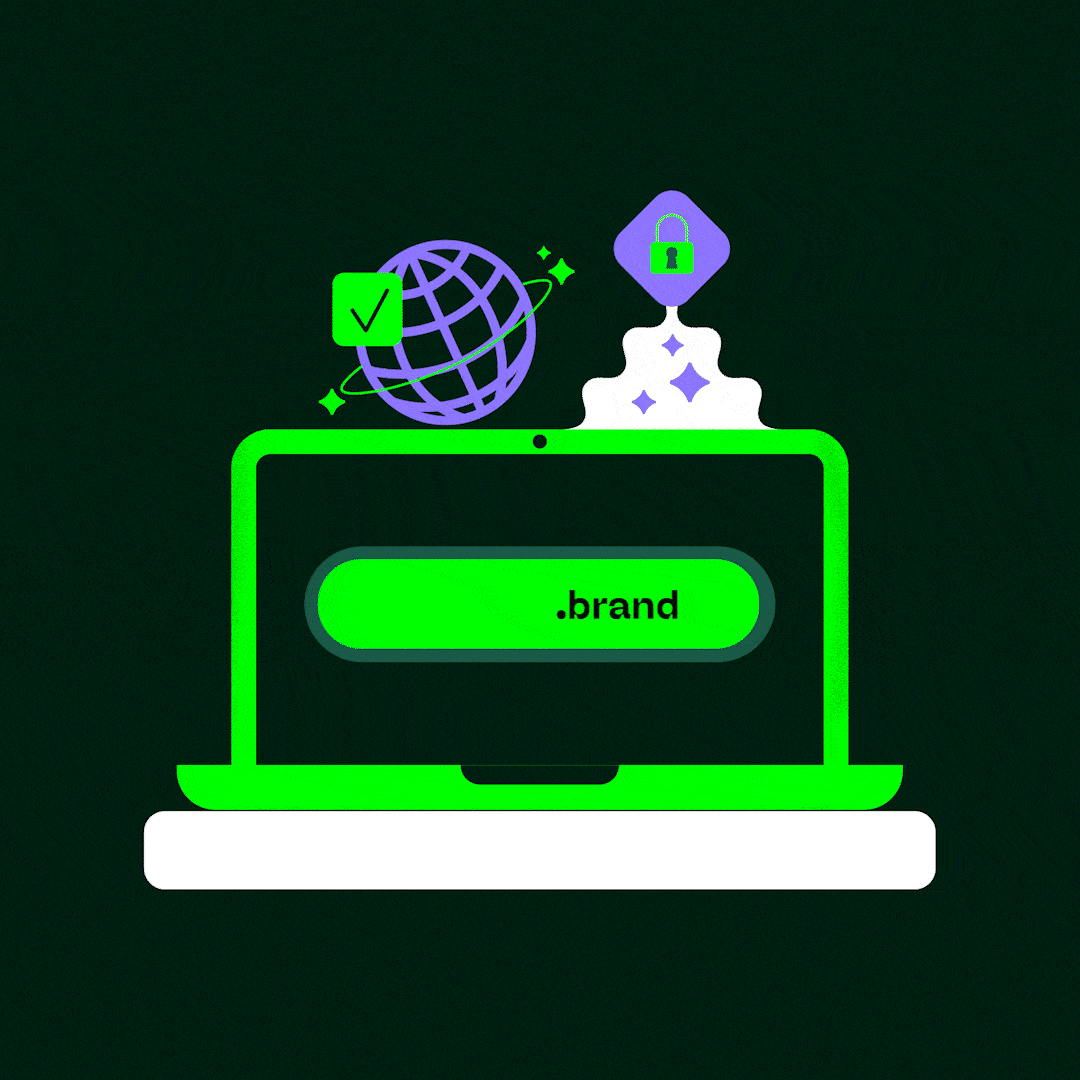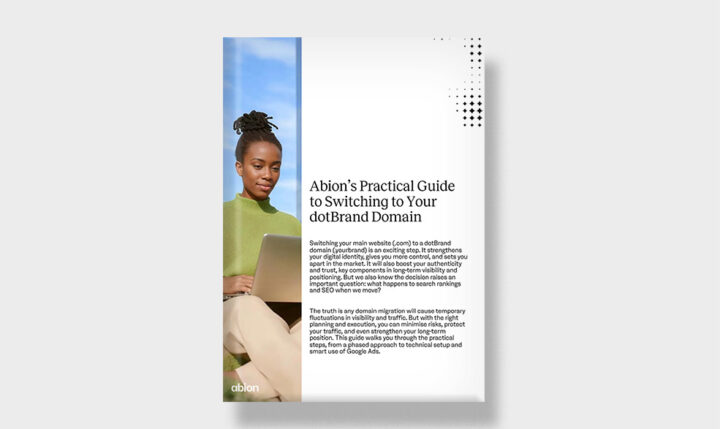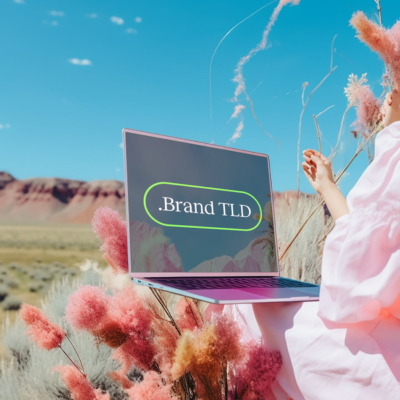Welcoming Haydn Simpson to Abion: Leading the Future of dotBrand
- Announcements / Press releases
- Domains

In a strategic move to reinforce its leadership in digital IP management, Abion announces the appointment of Haydn Simpson, a seasoned expert in domains, brand protection, and online security, as its new Head of dotBrand.
With over 20 years of global experience advising some of the world’s most recognisable brands, Haydn’s appointment marks a key step in Abion’s mission to help clients take control of their digital identity. In his new role, he will lead Abion’s dotBrand advisory services and oversee the development of advanced domain portfolio strategies that align with clients’ digital growth objectives.
Haydn is widely recognised across the industry for his insight and commercial acumen, having built and scaled domain and brand protection programmes for multinational businesses. His arrival strengthens Abion’s ability to deliver expert-led guidance on dotBrand TLDs and helping clients unlock the full value of their digital assets.
We sat down with Haydn to talk about his new role, the return of dotBrand TLDs, and why a digital asset strategy has never been more important for forward-thinking organisations.
"In a world full of digital threats and disruption, a dotBrand TLD is one of the few things you can truly control. It becomes the stable platform your entire online presence can be built on.”
- Haydn Simpson, Head of dotBrand at Abion
You have extensive experience in domains and brand protection - can you tell us a bit about that and what led you to specialise in the dotBrand space?
It all began in 2002-I fell into the domain industry through a sales role at NetNames. That evolved quickly into a global position where I advised some of the world's most recognised brands like British Airways and Warner Bros on navigating this “new” digital landscape. Over time, I moved into brand protection, building teams, managing multimillion-pound portfolios, and working with high-value clients in IP, anti-counterfeiting, and online enforcement.
What’s kept me in the industry for over 20 years is the pace of change and the strategic value we can bring to clients. The internet is constantly evolving, and I love helping brands stay one step ahead of threats-whether it’s fraud, infringement, or simply the challenge of reaching consumers in a secure and trusted way.
So what drew you to Abion specifically?
I’ve worked with Abion as a client before-twice, in fact-so I knew the bar was high. I admire the “customer first” ethos and the ambition here. The role at Abion lets me combine my full experience-domains, brand protection, web security, and helping companies (and my employer!) to harness growth in the digital channel -at a time when the industry is on the cusp of real change. No-one has yet got right what Abion is trying to achieve. Couple that with the next round of new gTLDs (generic top-level domains) approaching, I saw a chance to help both clients and Abion build for the future.
As the internet has matured, brands have had to wrestle with escalating digital threats, increasing consumer expectations, and a fractured online landscape. The launch of a new round of gTLDs, including dotBrands, offers a rare opportunity to reimagine trust, control, and strategy in the domain ecosystem. And that’s exactly where I can advise.
Let’s talk about that change. How would you explain a dotBrand TLD to someone outside the industry?
At its core, a dotBrand TLD lets you own and control your own slice of the internet. Instead of building your digital identity on rented space, like “yourbrand.com”, you create your own top-level domain, like “.yourbrand”, where you have ultimate control over domain creation and the ecosystem associated with them.
You can’t underestimate the power of this opportunity. Today’s internet is a crowded space, full of competitors and bad actors using the same tools, like domains and email, to get ahead, impersonate companies and trick consumers. With a dotBrand, you’ve got the chance to put in place a secure and trusted place that you leverage. You can say, “Unless it ends in dotBrand, it’s not us.” and that gives you a new level of authenticity, security, and control that you simply can’t get with traditional domains.
And it goes beyond just safety, into the internet of the future. Consumers search differently now. They don’t type full URLs, they search the brand, speak to their smart devices or rely on AI suggestions. Owning your own TLD allows you to shape those experiences and build direct, trustworthy routes to engage your audience. It’s part of a much larger shift towards brand-owned infrastructure.
There’s still some mystery or hesitation around dotBrand TLDs. What do you think holds brands back?
Two big misconceptions: it's complicated, and it’s expensive. In truth, we, alongside registry service partners, will take care of the technical complexity. Brands don’t need to be experts to own a dotBrand, just like you don’t need to know how DNS works to use email. And as for the cost, well, let’s put it in perspective. Let’s keep it simple and say that if you’re a company turning over €100 million a year and spending 10% of that on marketing, a dotBrand might cost you less than 1% of your marketing budget annualised over the next 10 years. For an asset that can improve brand trust, minimise fraud, streamline digital strategy, and also reduce costs in other business areas like paid ads and security, that is, in my opinion, a strong investment.
The key is to shift from thinking of domains as a defensive necessity to seeing them as a revenue-generating part of an optimised strategic infrastructure. And that’s what a dotBrand gives you.
"For less than 1% of a typical marketing budget, a dotBrand TLD becomes a long-term digital asset that reduces risk, builds trust, and helps you grow your business more efficiently."
- Haydn Simpson, Head of dotBrand at Abion

What kind of businesses should be thinking about dotBrand TLD?
Honestly, any business with a digital presence. But especially those in industries vulnerable to fraud, counterfeiting, or reputational damage - like finance, pharma, luxury goods, FMCG, and even governments.
For example, banks are constantly dealing with phishing threats. Communicating with customers using a dotBrand cuts through the noise and the recipient knows it is 100% trustworthy. Or think about luxury brands wanting to protect high-end ecommerce, a dotBrand gives them a secure, exclusive platform, a destination free from counterfeits. Even industrial companies that don’t sell direct to consumers can use dotBrand to protect their supply chains, business dealings, and partner communications.
And let’s not forget the ‘get-ahead’ factor. Entrepreneurs or disruptive brands launching with a dotBrand are making a clear statement, that they’re digital-first, future-ready, and serious about trust.
How does the dotBrand strategy differ from a traditional domain strategy?
The most important thing is to have a strategy in the first place that takes into account trademarks, domains and brand protection. A dotBrand evolves that strategy, it does not replace it. For example, you don’t need to abandon your current portfolio of brand.com, brand.co.uk, or brand.de. In fact, you’ll still want to register defensively and use other domains, but over time, as a dotBrand becomes your digital home, your reliance on those third-party TLDs could decrease. It is about balance, driven by you through data analytics and having the options available to you.
The big difference is control. With dotBrand, you become the registry. You decide what’s created, who uses it, and how it operates. That kind of centralisation is powerful. It means fewer gaps for attackers to exploit and more opportunities to deliver a consistent, branded experience, across every touchpoint.
Where does dotBrand fit into the Web3 and decentralised identity conversation?
I see dotBrand as a stabilising force in an otherwise potentially chaotic digital ecosystem. Web3, decentralised wallets, blockchain domains, they’re still the Wild West. There’s no guarantee of interoperability or longevity. But dotBrand TLDs are built on solid, regulated infrastructure that’s globally recognised.
You don’t need to pick between dotBrand and emerging tech. In fact, owning a dotBrand puts you in a stronger position to integrate with whatever comes next. Whether it’s AI, voice search, or new Web3 protocols, you’ve got a stable, secure foundation. Your namespace is yours.
Lastly, what message would you give to CMOs, CTOs, or digital leaders who haven’t explored dotBrand yet?
My question to them is: Can you afford not to explore the possibilities?
This opportunity doesn’t come around often. If you miss this round, you could be waiting potentially another thirteen years. And in that time, the brands that do move forward with a dotBrand will have a strategic advantage - more trust, more control, and a clearer digital identity.
If you’re serious about growing and protecting your digital presence, then not exploring dotBrand isn’t cautious, it’s shortsighted. At Abion, we’re here to guide the process and help you make an informed decision. But you need to take that first step.
Want to explore what a dotBrand TLD could look like for your business?
Get in touch with Haydn and the Abion team to schedule a feasibility workshop.
Take the first step to owning your brand today.



